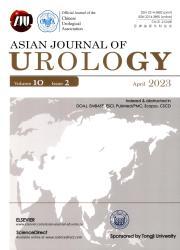Sono-urethrogram versus conventional urethrogram in the assessment of urethral stricture disease: A prospective comparative study
IF 2.4
3区 医学
Q2 UROLOGY & NEPHROLOGY
引用次数: 0
Abstract
Objective
The management of urethral stricture disease depends on the location, length of stricture, and associated urethral pathology. These parameters are obtained from preoperative imaging, with conventional urethrogram (retrograde urethrogram and micturating cystourethrogram [RGU/MCU]) being the diagnostic tool of choice despite its many shortcomings. Sono-urethrogram (SUG) is an alternative that addresses most issues of RGU/MCU. Studies comparing RGU/MCU with SUG are limited. With the objective of comparing these two imaging modalities in the evaluation of urethral stricture disease, a prospective study was conducted.
Methods
Fifty-six patients suspected of urethral stricture disease on clinical evaluation and confirmed either on RGU/MCU or urethro-cystoscopy were included in the study. SUG was performed by the experienced consultant radiologist who was blinded to the report of RGU/MCU. Findings of RGU/MCU and SUG were compared to intraoperative findings, which served as the reference standard.
Results
The median length of the stricture determined intraoperatively was 16.5 mm, by RGU/MCU was 5.8 mm, and by SUG was 13.5 mm. The diagnostic accuracy for determination of the stricture location was 93% for RGU/MCU and 98% for SUG. SUG identified spongiofibrosis in 90% of patients with higher accuracy for the severe degree of spongiofibrosis.
Conclusion
SUG has been shown to be more accurate than RGU/MCU in estimating stricture length (both short and intermediate) and localizing the stricture location. Use of SUG in conjunction with RGU/MCU helps in better guidance of stricture management by improving preoperative assessment. Further studies with larger sample sizes are warranted.
超声尿道造影与常规尿道造影评估尿道狭窄疾病的前瞻性比较研究
目的尿道狭窄疾病的处理取决于狭窄的位置、长度和相关的尿道病理。这些参数来自术前影像学,常规的尿道造影(逆行尿道造影和排尿膀胱造影[RGU/MCU])是首选的诊断工具,尽管它有许多缺点。超声尿道造影(SUG)是一种解决RGU/MCU大多数问题的替代方案。比较RGU/MCU与SUG的研究有限。为了比较这两种成像方式对尿道狭窄疾病的评价,我们进行了一项前瞻性研究。方法对56例经RGU/MCU或尿道膀胱镜检查证实的临床诊断为尿道狭窄的患者进行研究。SUG由经验丰富的放射科顾问医师执行,他对RGU/MCU的报告一无所知。将RGU/MCU和SUG结果与术中结果进行比较,作为参考标准。结果术中狭窄中位长度为16.5 mm, RGU/MCU法为5.8 mm, SUG法为13.5 mm。RGU/MCU对狭窄位置的诊断准确率为93%,SUG为98%。SUG在90%的患者中识别出海绵状纤维化,对于海绵状纤维化的严重程度具有更高的准确性。结论sug在估计狭窄长度(无论是短的还是中间的)和定位狭窄位置方面都比RGU/MCU更准确。SUG与RGU/MCU联合使用有助于改善术前评估,更好地指导狭窄管理。更大样本量的进一步研究是必要的。
本文章由计算机程序翻译,如有差异,请以英文原文为准。
求助全文
约1分钟内获得全文
求助全文
来源期刊

Asian Journal of Urology
UROLOGY & NEPHROLOGY-
CiteScore
4.00
自引率
3.80%
发文量
100
审稿时长
4 weeks
期刊介绍:
Asian Journal of Urology (AJUR), launched in October 2014, is an international peer-reviewed Open Access journal jointly founded by Shanghai Association for Science and Technology (SAST) and Second Military Medical University (SMMU). AJUR aims to build a communication platform for international researchers to effectively share scholarly achievements. It focuses on all specialties of urology both scientifically and clinically, with article types widely covering editorials, opinions, perspectives, reviews and mini-reviews, original articles, cases reports, rapid communications, and letters, etc. Fields of particular interest to the journal including, but not limited to: • Surgical oncology • Endourology • Calculi • Female urology • Erectile dysfunction • Infertility • Pediatric urology • Renal transplantation • Reconstructive surgery • Radiology • Pathology • Neurourology.
 求助内容:
求助内容: 应助结果提醒方式:
应助结果提醒方式:


